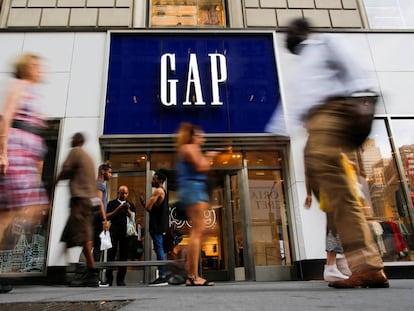In a first, Inditex closed more stores than it opened in last quarter of 2017
Parent company of Zara says closures are due to absorption into bigger and newer premises


Inditex does not like to say that it is closing stores. Instead, the parent company of fashion giant Zara prefers to talk about “absorptions.”
In its 2017 fiscal year (February 1, 2017 to January 31, 2018), Inditex shut down 341 stores, even though the company insists on calling them absorptions because, it says, what they are really doing is implementing a 2012 plan to replace smaller, older establishments with huge new flagship stores in the same area.
The retail fashion group released its FY2017 results on Wednesday, revealing net sales of €25.3 billion, a 9% rise from the previous year. Gross profit reached €14.3 billion, 7% higher than in FY2016, and net income was €3.4 billion.
Closed or absorbed?
Under its absorption policy, Inditex ended 2017 with 7,475 stores in 97 global markets. In total there were 524 openings and 341 closures, for a net growth of 183 stores and representing the most openings since 2012.
The record was set in 2007, when net store openings amounted to 570. Last year, the pace of closures picked up in the fourth quarter, when, for the first time in the company’s history, there was a negative balance of 29.
For the first time, the company revealed how much it makes from online sales
Are all closed stores really being absorbed by bigger ones? According to Inditex chairman and CEO Pablo Isla, who presented the company results on Wednesday, nearly all of them are.
“The vast majority are, I’d say 90%. Closures are anecdotal,” he said, noting that these closing establishments are old and make no sense in today’s corporate strategy of picking out large, efficient premises in prime locations.
Isla also noted that what counts is total selling area, which reached 4,739,427 square meters at the end of the fiscal year, a 7% rise from 2016.
The CEO said that this substitution program began in 2012 and will continue through 2018, when there will be “an estimated 200 store absorptions.”
More closures in Spain
Broken down by countries, the most store openings took place in Turkey, followed by Mexico, Italy, Saudi Arabia and China.
The opposite trend was seen in Spain, which is its most mature market as the company was born there. There are 1,688 Spanish stores selling Inditex brands – Zara, Massimo Dutti, Bershka, Stradivarius, Pull&Bear, Oysho, Zara Home and Uterqüe – twice as many as in the second-largest market, China. The net balance in 2017 for Spain was 99 closures.
Isla said that Spain is a good example of the absorption policy: the selling area did not change despite these shutdowns. Also, 1,900 jobs were added in the country, as the closures were offset by 39 openings and 84 enlargements.
These openings include the new Zara store on Madrid’s Paseo de la Castellana, now the largest in the world with 6,000 square meters. And in Valencia, the company opened a Massimo Dutti store covering 1,500 square meters over three floors.
Online sales
Besides reorganizing its physical stores, Inditex is also focusing on online sales. The company’s virtual stores, organized around “a global store and online platform,” have a presence in 49 markets, and the technology required to run them efficiently has attracted record investment of €1.8 billion.
CEO Pablo Isla noted that what counts is total selling area
For the first time, the company revealed how much it makes from this activity: “Online sales grew 41% to 10% of net sales in 2017,” said the company in its FY2017 results statement. This represents around €2.5 billion.
While Inditex trumps the competition when it comes to sales in physical stores, its direct rival GAP makes around the same from its online sales, even though its net sales are around half that of the Spanish giant, which made €25.3 billion in the last fiscal year. H&M does not offer specific figures, while Mango had online sales of €294 million in 2016.
English version by Susana Urra.
Tu suscripción se está usando en otro dispositivo
¿Quieres añadir otro usuario a tu suscripción?
Si continúas leyendo en este dispositivo, no se podrá leer en el otro.
FlechaTu suscripción se está usando en otro dispositivo y solo puedes acceder a EL PAÍS desde un dispositivo a la vez.
Si quieres compartir tu cuenta, cambia tu suscripción a la modalidad Premium, así podrás añadir otro usuario. Cada uno accederá con su propia cuenta de email, lo que os permitirá personalizar vuestra experiencia en EL PAÍS.
¿Tienes una suscripción de empresa? Accede aquí para contratar más cuentas.
En el caso de no saber quién está usando tu cuenta, te recomendamos cambiar tu contraseña aquí.
Si decides continuar compartiendo tu cuenta, este mensaje se mostrará en tu dispositivo y en el de la otra persona que está usando tu cuenta de forma indefinida, afectando a tu experiencia de lectura. Puedes consultar aquí los términos y condiciones de la suscripción digital.
More information
Archived In
Últimas noticias
The complicated life of Francesca Albanese: A rising figure in Italy but barred from every bank by Trump’s sanctions
Reinhard Genzel, Nobel laureate in physics: ‘One-minute videos will never give you the truth’
Pinochet’s victims grapple with José Antonio Kast’s rise in Chile
How Japan is trying to avert ‘digital defeat’
Most viewed
- Pablo Escobar’s hippos: A serious environmental problem, 40 years on
- Reinhard Genzel, Nobel laureate in physics: ‘One-minute videos will never give you the truth’
- Why we lost the habit of sleeping in two segments and how that changed our sense of time
- Charles Dubouloz, mountaineering star, retires at 36 with a farewell tour inspired by Walter Bonatti
- The Florida Keys tourist paradise is besieged by immigration agents: ‘We’ve never seen anything like this’










































